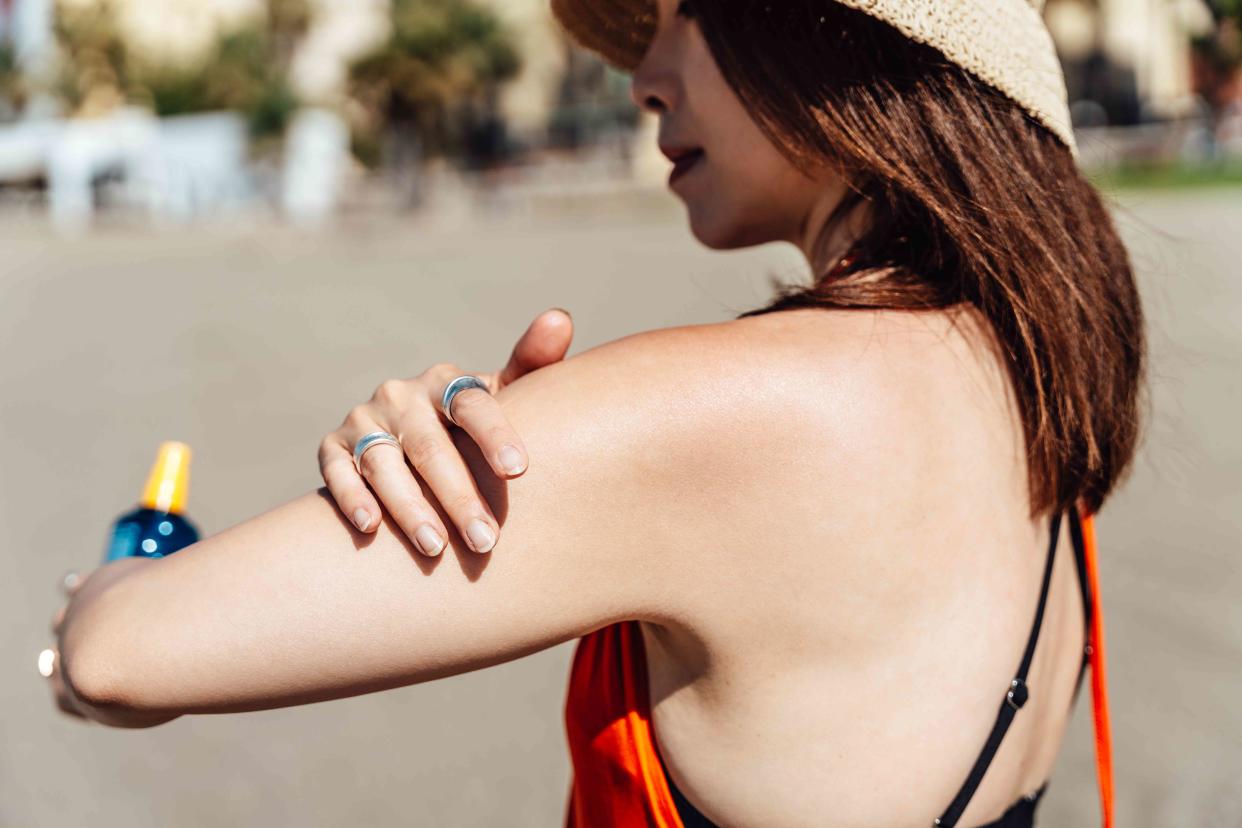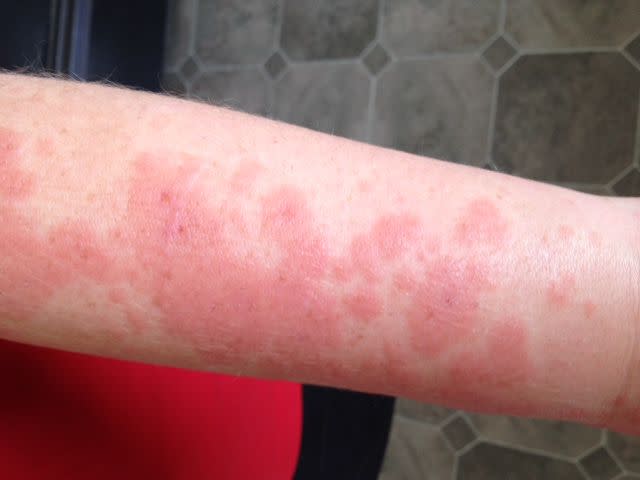What Is a Sun Rash?

Oscar Wong / Getty Images
Medically reviewed by Casey Gallagher, MD
A sun rash causes red, itchy bumps on your chest, arms, and legs. Polymorphous light eruption (PMLE) is the most common sun rash. It typically occurs in the spring or summer, when you spend more time in the sun. Symptoms include small bumps or blisters, swelling, and itching or burning.
Genetics and having lighter skin are two common causes of sun rash. It usually disappears within 1-2 weeks and occurs less frequently as your skin gets used to the sunlight.
Types
Sunlight exposure can lead to various types of skin reactions. These reactions can occur due to genetics (heredity), environmental factors, and individual differences in skin sensitivity. Examples of skin reactions from sunlight include:
Polymorphous light eruption (PMLE): PMLE is the most common type of sun rash. It occurs when sunlight causes an immune response leading to small, flat, red bumps.
Sunburn: A sunburn occurs with too much sun exposure. It causes flat, red, painful skin that may blister or peel.
Solar urticaria: This is a rare sun allergy that causes hives (red, swollen bumps) and sometimes swelling of the eyes and mouth shortly after sun exposure. This rash can occur even if you wear light clothing to cover your skin. It typically resolves within 24 hours.
Drug-induced photosensitivity: This occurs when certain medications, such as Vibramycin (doxycycline) or other antibiotics, make your skin more susceptible to the sun.
Photocontact dermatitis: This skin condition occurs when certain chemicals that touch your skin react with sunlight, making your skin more sensitive. These chemicals can be found in fragrances, dyes, sunscreen, and some fruits and vegetables (like celery, parsley, figs, and citrus). They can cause skin irritation, redness, or blistering that looks like a bad sunburn.

DermNet
Symptoms
Sun rash symptoms typically appear when you are in intense sunlight for the first time in the spring or early summer. They usually start as small, smooth, flat red bumps on your chest, arms, and legs. Your face and hands are less likely to get this rash because those areas have more sunlight exposure throughout the year. You may also notice:
Plaques (when bumps join together to form larger, raised patches)
Vesicles (tiny fluid-filled blisters)
Circular marks with a target-like appearance
Itching or burning in the area with the rash
Sun rashes can develop minutes to hours after sun exposure, but they might appear up to 1-4 days later. Rashes typically resolve within 14 days, especially if you avoid sunlight exposure, but they may take longer to resolve with repeat sun exposure. They usually clear up without leaving scars.
Some people get sun rashes every summer. As you spend more time in the sun, your skin might become less sensitive, and the reactions might not occur as often or be as severe.
What Causes Sun Rash?
An atypical immune system response to sunlight exposure causes polymorphous light eruption (PMLE), the most common type of sun rash. Most people who get a sun rash have a family history or genetic predisposition.
Your immune system protects your body from harmful invaders like germs. When ultraviolet (UV) radiation (sunlight) touches your skin, your immune system typically sees no danger and stays calm. However, with conditions like PMLE, the immune system thinks the sunlight is harmful and goes into overdrive. The redness and swelling is a protective measure.
Risk factors for developing PMLE include:
Being assigned female at birth
Ages 20-40 years
Northern European origin
Having very fair skin (burning easily and rarely tanning)
Family history of PMLE
Diagnosis
Healthcare providers typically rely on a physical examination and a medical history to identify rash patterns. They may also suggest diagnostic tests to diagnose specific sun-related conditions.
Examples of diagnostic tests include:
Phototesting: Exposing your skin to different wavelengths of light to see if it triggers a rash
Patch testing: Applying small amounts of substances to your skin to see if they cause a reaction
Blood tests: Various blood tests to help rule out other conditions that might be causing your symptoms
Skin biopsy: Removing a small piece of skin and examining it under a microscope to check for irregularities
Sun Rash Treatment
Treatment for sun rashes focuses primarily on easing symptoms and preventing future flare-ups. Your primary care provider may refer you to a dermatologist—a medical doctor who specializes in skin, hair, and nail conditions.
Your provider may prescribe topical (on the skin) or oral (by mouth) corticosteroids to suppress your immune response and reduce swelling and itching. For severe cases, treatment may involve phototherapy, which involves exposing your skin to controlled amounts of UV light to decrease your skin's sensitivity to it.
Home Remedies
Scratching your rash can increase your risk of infections and scarring. Consider the following home remedies for red, itching, or burning skin:
A cool compress or cool bath
Over-the-counter (OTC) hydrocortisone cream or anti-itch cream
OTC pain medications like Motrin or Advil (ibuprofen) for discomfort
Adding colloidal oatmeal to a lukewarm bath
Oral antihistamines like Benadryl (diphenhydramine) or Zyrtec (cetirizine)
How To Prevent Sun Rash
You can prevent a sun rash by following recommendations such as the following:
Avoid direct sunlight exposure and seek shade when outdoors
Wear protective clothing, including hats, sunglasses, and sunshirts
Use a sunscreen with SPF 50 or higher, and reapply every two hours
Consider using websites and smartphone apps to monitor local UV levels
Your healthcare provider may recommend preventive courses of oral steroids or Plaquenil (hydroxychloroquine)—a medication that typically treats malaria—before special occasions or trips. They may also suggest regularly taking oral antioxidant supplements before sun exposure. These antioxidants might include:
Polypodium leucotomos extract: Extract from a tropical fern
Lycopene: From tomatoes and other red fruits
Beta-carotene: In carrots and orange fruits (converts to vitamin A in the body)
Nicotinamide: Also known as vitamin B3
Astaxanthin: Found in algae and seafood like salmon
Complications
A sun rash does not typically cause complications, but severe rashes can lead to:
Skin infection, especially with excessive scratching
Scarring, especially with excessive scratching or infection
Emotional distress or activity limitations due to discomfort
A Quick Review
Sun rash is a reaction that causes red bumps, blisters, or patches after exposure to sunlight. You might feel itchiness or a burning sensation. Polymorphous light eruption (PMLE) is the most common type of sun rash. It can occur within hours to days after exposure and results from a combination of genetic and immune-related factors.
Sun rash prevention includes avoiding sunlight, using sunscreen, and taking oral steroids or antioxidants as a preventative measure before special occasions. Treatment involves oral or topical steroids, cool compresses, anti-itch creams, and phototherapy. Sun rashes typically become less frequent as you're exposed to more sunlight—for example, as the spring and summer seasons progress.
Frequently Asked Questions
Does Benadryl help a sun rash?
Benadryl (diphenhydramine) is an antihistamine that can alleviate symptoms like itching and swelling. It's available as a pill or capsule you take by mouth or in skin creams. Other oral antihistamines like Claritin (loratadine), Allegra (fexofenadine), and Zyrtec (cetirizine) may also help with itching or hives.
What is the difference between a sun rash and a sun allergy?
The most common type of sun rash, polymorphous light eruption (PMLE), is an abnormal immune response to sunlight exposure, causing red, itchy patches or bumps on the skin. It typically occurs with the first exposure to strong sunlight in the spring or summer.
Solar urticaria, a rare allergic reaction to the sun, causes hives and swelling almost immediately after sunlight exposure. Hives are red, raised, and itchy welts on the skin.
How long does it take for a sun rash to go away?
Depending on its severity, a sun rash can last from a few days to a couple of weeks. However, it typically resolves faster if you avoid the sun until it heals.
For more Health.com news, make sure to sign up for our newsletter!
Read the original article on Health.com.

